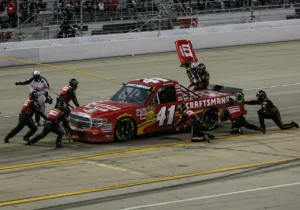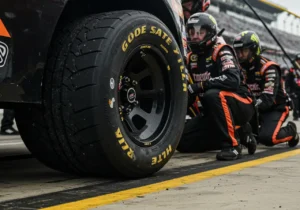The NASCAR Craftsman Truck Series made its long-awaited return to
 New Hampshire Motor Speedway in 2025 for the first time since 2017. Fans
New Hampshire Motor Speedway in 2025 for the first time since 2017. Fans
packed into Loudon to witness a crucial elimination race that delivered drama, strategy,
and standout performances. Corey Heim’s dominant run — earning his record-tying ninth
victory of the season — was the weekend’s headline, but the race offered plenty of
lessons for teams and drivers across New England.
1) Track Position Proved More Valuable Than Raw Speed
At New Hampshire, clean air is king. Trucks that restarted near the front gained
outsized advantages even when their lap times weren’t the fastest. Restarts became
opportunities to lock in track position, and crew chiefs who timed pit calls to cycle
forward held the upper hand. For local teams studying race film, the lesson is clear:
winning the battle off pit road can be more important than shaving a tenth of a second
in qualifying.
2) Tire Wear Rewarded Discipline
Despite being a one-mile oval, NHMS tested tire conservation like a worn short track.
Drivers who over-drove the corners saw the right-front wear accelerate, hurting exit
speed during long green-flag runs. Heim and other front-runners demonstrated throttle
patience and smooth braking that protected rubber without giving up much time.
New England racers at bullrings like Waterford Speedbowl can take note: restraint often
wins longer runs.
3) Pit Timing Beat Pit Quantity
 Some teams gambled on three stops, but those who managed to pit during the right
Some teams gambled on three stops, but those who managed to pit during the right
caution cycles — often making just two clean stops — gained the track position needed
to control the race. Pit-road strategy became a chess match, highlighting the value of
communication between spotters, crew chiefs, and drivers.
4) Adaptive Lines Paid Off in Traffic
While leaders defended the low groove, movers in the pack experimented with
alternative entries. Some diamonded the corners, entering high and cutting down late
to open up corner exit speed. Others rolled the outside line just enough to maintain
momentum. The ability to adjust to traffic separated those stuck mid-pack from those
climbing toward the top ten.
5) Playoff Pressure Raised the Execution Bar
Because the Loudon race was an elimination event, every pit stop, restart, and
on-track decision carried greater weight. Teams under playoff stress tended to make
fewer mistakes, but when errors did happen, they were magnified. Local New England
series can learn from this: when season points are on the line, consistency and calm
execution often outweigh sheer speed.
6) Momentum Is Contagious
Heim’s streak wasn’t just about fast trucks — it was about confidence and rhythm.
Teams that unload well, execute pit stops cleanly, and manage race flow can build
momentum that carries from week to week. For regional teams, maintaining consistent
preparation routines can generate similar confidence across multiple tracks.
7) Why It Matters for New England Truck Racing
The ripple effects from NASCAR’s return to Loudon extend beyond the national series.
Regional drivers and teams now have a blueprint for how big-stage racing rewards
patience, adaptability, and pit execution. Here are three key takeaways for New England:
- Setups: Balance matters more than raw speed. Build cars that
survive the long run without losing handling balance. - Weather prep: Weather shifts can change strategy quickly. See
our guide on wet-weather tires for short tracks. - Regional buzz: A national spotlight on New Hampshire fuels
interest in local events. See our recap of Lime Rock Park’s LiUNA! 150 for proof of how big races lift regional racing.
Looking Ahead
New Hampshire’s return to the Truck Series schedule was more than just a one-off
event. It reminded fans and competitors that New England tracks can host nationally
significant races with lessons that echo across the sport. For local teams, the
takeaways are actionable: protect tires, value track position, communicate under
pressure, and ride momentum. With playoff pressure on the horizon, these lessons
may separate champions from contenders.
Internal Links for Further Reading:

